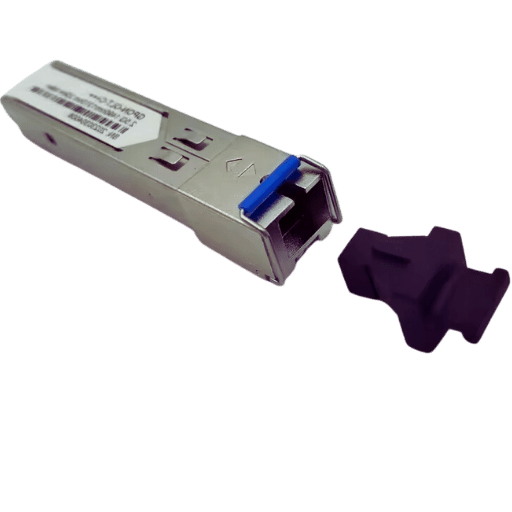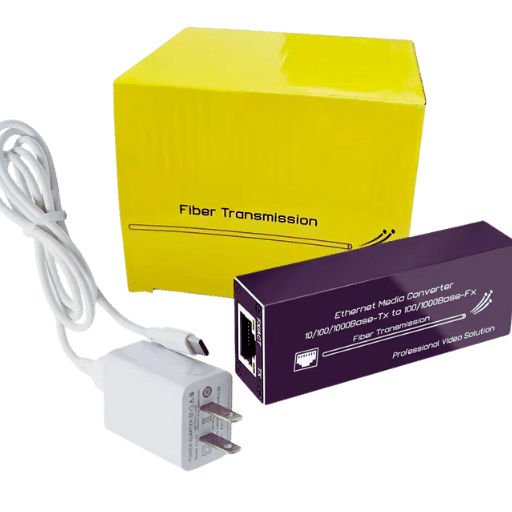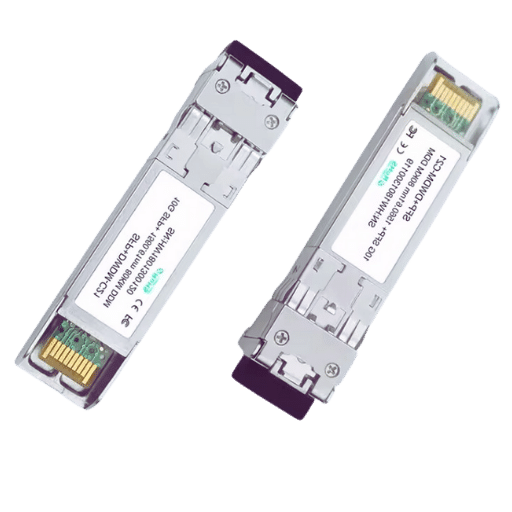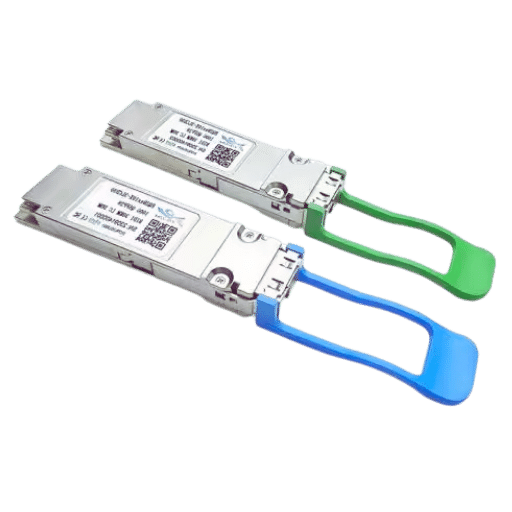When talking about transceiver modules, GBIC (Gigabit Interface Converter) and SFP (Small Form-factor Pluggable) are among the most commonly used terms in networking. This is because they both function by converting electrical signals to serial optical signals and vice versa thereby enabling different network devices to communicate with each other. However, there are some differences that need to be taken into account between them. Firstly, the GBIC module is bigger and was one of the earliest transceiver formats used in networking. It supports the Gigabit Ethernet standard and is used in switches as well as routers for fiber optic and Ethernet connections. Conversely, the SFP module, which came later after GBIC, was designed to improve upon its design by being smaller in size than it. Additionally, this module can support not only Gigabit Ethernet but also faster speeds, like ten or even 100 Gigabits per second, depending on the specific model of SFP being used. Such flexibility, together with compactness, has made SFPs more widely adopted today than any other type of optic module, thus allowing higher port density in network devices currently employed within different networks around the globe.
Different physical sizes and form factors enormously differentiate GBIC from SFP modules, which affects their use in various networking environments. If we compare them with each other, GBIC modules are quite big, which is why they were suitable for network design in the earlier days, which did not require high-density port configuration. However, this compactness of size allows SFP to have more ports per unit area on devices used in networks where there is limited physical space available, like switches or routers. The above statement implies that while a device can only accommodate a few numbers of GBICS’ within its given dimensions, it can take many more SFPS.’ Some key points describing these features are as follows:
It is important to comprehend these distinctions between form factors when designing network infrastructure because sometimes space constraints together with a number of required ports might be an issue.
Beyond physical distinctions, there is a big discrepancy in technical capabilities between GBIC and SFP modules. GBICs can only handle lower data transfer speeds that usually do not exceed 1 Gbps since they are an outdated technology. This means they were good enough for past networking needs but cannot meet current high-speed requirements anymore. Conversely, SFP module designs allow for higher data rates, which start at 1Gbps and reach up to 10Gbps or beyond if we consider SFP+ versions, thus addressing the demand for increased bandwidth in modern network infrastructures. On top of this feature alone, other benefits include support for more types of optical fibers and longer distances by SFP modules compared with GBICs, thereby making network planning and operation easier through flexibility as well as efficiency enhancements within them. Furthermore, both these kinds of transceivers support various communication mediums such as copper or fiber optics; however, advancements made on SFPs have resulted in better performance while being compliant with contemporary standards used in networks today.
As far as fiber optic cables are concerned, GBIC transceivers and SFP transceivers are both flexible, but SFP modules of the latter type can be used with a wider range of fiber optics. This involves multimode fibers that work over short distances or single-mode fibers that can transmit data over long distances at higher speeds. In order not to lose any speed or integrity in data transfer, SFPs were created to work with many different types of optical fibers hence making it possible for them to cover longer connections than any other module can do without this feature. The advent of SFP+ increased its speed even further while still being able to reach farther than before, which is why it has become so popular among those who need such things done on their computer networks where there might be lots of these cables lying around all interconnected together!

The SFP module’s smaller size has one great advantage: it frees up significant space on network devices. In this way, port density can be increased, leading to the accommodation of more optical connections within the same hardware footprint. This improved efficiency can save costs and enable seamless scaling for busy data centers or network environments with limited space. Another thing is that these small form-factor pluggable transceivers have good airflow through them due to their compactness which in turn enhances long-term reliability as well as thermal management. It is clear from these advantages why most people in the field choose SFP modules rather than larger GBICs.
The SFP+ module, an advanced version of GBIC, is known for being able to work with faster data rates and is therefore considered a significant step forward in networking. Here’s what it does:
To conclude, moving from GBICs to fiber optic transceivers such as SFP pluses marks one giant leap toward designing future-ready networks. These types of modules offer speedier connections alongside better efficiency and sustainability features that will help meet demands brought about by increased connectivity demand.
The compatibility of SFP modules with current devices is an important factor for seamless integration into the existing and forthcoming network infrastructures. Here are the main parameters on which their compatibility is based:
In summary, what makes them compatible with contemporary systems includes their physical dimensions being standardized; support for different rates of data transfer coupled with types of fiber optics employed; inclusion of more advanced diagnostic features plus ability to work alongside diverse vendor equipments where necessary. All these qualities enable them meet today’s demanding and ever changing network environments.

GBIC modules can prove to be particularly useful in several situations because they are larger compared to their SFP counterparts. Firstly, GBICs allow for better heat dissipation in environments where there is a need for thermal management, therefore making them ideal for devices with many densely packed optical interfaces. Secondly, when it comes to networks that are transitioning or upgrading their systems, GBIC modules can integrate seamlessly with older hardware so as to accommodate legacy systems while providing the required bandwidth and performance levels necessary for modern applications. Lastly, education institutions or labs where modules need to be handled frequently and interchanged often benefit from the fact that GBICs have bigger sizes, which make them stronger and easier to work with during manual interventions, thus reducing the chances of damage happening through such processes.
The GBIC modules are designed to be backward compatible so that they can work with older systems. This is possible because of the following reasons:
Therefore, if all these aspects are taken into account; then GBIC modules will effectively act as an interface between new networking technologies and old equipment so as to promote smooth operation while at the same time extending the life span of current infrastructure.
When it comes to GBIC modules, there are two main port options available for users: copper ports and optical fiber ports. The decision between them mostly relies on the application being used and the network environment.
Copper ports are known for their affordability and reliability in short distance connections. Often times employed within data centers that require quick transmission of large amounts of data over small distances. These types of ports can be easily installed or maintained due to their strong resistance against physical damage, thus making it a convenient choice for many businesses.
Alternatively, optical fiber ports excel when it comes to situations where high speeds need to be transmitted across long distances without loss of signal integrity. They are not affected by electromagnetic interference, which may prove critical under certain conditions. Also, multi-mode fibers have been introduced alongside single-mode fibers, thereby giving more flexibility and scalability in designing networks, thus meeting different operational needs.
In summary, choosing between copper or optic fiber-based gbic module ports depends on finding a balance among range limitations, speed requirements as well and financial resources available. If there is a need for fast communication over bigger areas, then one should go with fiber, while those concerned about costs will find copper suitable for short-range deployments.

In order to upgrade from GBIC to Small Form-factor Pluggable (SFP) modules without causing any problems on your network, there are a number of things you need to do. It is similar to changing from an old car that has served you well for years into a newer model – everything should fit in place and perform better.
If you follow these steps in order, upgrading GBIC to SFP modules will greatly improve your network’s power and make it future-ready.
To avoid compatibility and interface troubles while migrating from GBIC to SFP modules, it is important that you do some investigation and perform compatibility checks before purchasing anything. A manufacturer may offer a product sheet with detailed information about their products as well as guides on what will work together. These resources should help you determine which SFP module would best suit your needs in relation to the existing infrastructure. Also, try getting flexible or programmable ones which can be configured for use with different devices or networks since this may be necessary when dealing with varied systems. Moreover, you could talk to an informed supplier who specializes in network upgrades or consultancies dealing with such issues; they are likely to give personalized suggestions based on their knowledge and skills in this area, thereby ensuring that everything goes smoothly without affecting the continuity of service delivery by these systems.
The switchover from GBIC to SFP modules is very costly for companies, and though this has many technological advantages, careful consideration is required. In the first place, there are a variety of SFP modules that vary in price depending on their performance specifications and compatibility requirements; hence, organizations will have to buy them. Equally important is upgrading or replacing existing equipment so that they can support this SFP technology, which may also incur some charges. Another thing that adds to overall costs is training staff about new systems and perhaps employing outside consultants to ensure a smooth transition. However, what should not be forgotten is that in spite of these initial costs, long-term benefits like enhanced network performance, efficiency, and scalability can bring about significant savings, thus justifying the investment made. Some financial impacts can be reduced by effective budget planning coupled with seeking cost-effective solutions; therefore, businesses need to assess both immediate and future monetary gains arising from moving onto SFP modules.

The architecture of gigabit Ethernet networks is heavily reliant on GBIC and SFP modules, which act as the main driving force behind fast data transfer. Here’s how:
Understanding how GBICs & SFPS work together with gigabits-Ethernet helps companies choose wisely when upgrading or designing their own infrastructure. Protocols must evolve not only to keep pace with changing times but also to enhance performance efficiencies as well as scalability towards future demands required out of them once utilized properly.
The modification from GBIC to SFP modules has the potential to greatly enhance data transfer rates, thus making network systems more efficient and effective. It is necessary to look at some of the key indicators in order to understand how much faster the data can flow.
In short words, switching from gbic to sfp represents significant advancement in design capability mainly characterized by increased speed capacities; higher port densities; better power efficiencies together with adaptable medias among others. All these factors basically add up, hence affecting overall speeds cumulatively, making them ideal for faster networks where performance is required most frequently, like modern infrastructures striving towards efficient utilization of communication resources.
When grading the trustworthiness of a transceiver module, it is important to consider multiple factors that determine its performance and usefulness in intricate networking environments. Firstly, physical endurance and electrical robustness are contingent upon how well the device is put together as well as its complexity of design. Compatibility with existing network equipment must be ensured lest seamless communication without loss or corruption of data occurs. Third-party certifications from recognized standard bodies could also mean module reliability. Moreover, manufacturer support services, together with warranties, can indicate faith in product durability and customer care commitment, respectively. Finally, feedback from users who have deployed these modules into real-world situations over time may give us some insights into their performances. All these things taken together help us come up with a system through which we can rate transceiver modules’ dependability while ensuring that we build our networks on strong components that will serve efficiently for long periods of time.

If you are planning out a new network or deciding between a GBIC and SFP transceiver module, there are a few important things to consider before making your choice. This will help ensure that your network runs smoothly and efficiently and is easily scalable in the future when needed. Here’s what those factors are:
Future-proofing – Try picturing a scenario where technology shifts suddenly occur only realize later after investing heavily into some hardware devices which cannot accommodate those changes thereby rendering them obsolete overnight.
When you are trying to figure out if GBIC modules are more or less costly than SFP ones, make sure that you take into account the long-term operational expenses apart from the initial purchase price. At first sight, a GBIC module might seem cheaper than an SFP module because it costs less money; nevertheless, they use up more space and electricity, which means that there will be considerable savings in energy over a period of time. Additionally, due to technological improvements and wider market availability, the prices of small form-factor pluggable transceiver modules have been dropping recently, but older gigabit interface converter transceivers can still be found comparatively cheaper initially but potentially leading to higher operational expenditures as well as compatibility problems with changing network requirements at later stages. Another thing worth mentioning is that buying some enhanced SFPs, such as the SFP+, may result in slightly higher costs at first when compared with standard SFPs, but this investment usually pays off through increased speed needed for faster transmission rates in future-oriented scale.
To steer your way through the intricacies of future-proofing a network, one must choose between GBIC and SFP modules based on scalability assessment, performance requirement, and power effectiveness of the network in question going forward. Go for small form-factor pluggable transceiver (SFP) modules if you want to save space when dealing with current high-speed data rates or planning for them in the future while keeping power consumption low at all times, which are also described as energy-saving. For instance, there are SFP+ types that allow more speed; hence, higher performance levels can be achieved, especially where traffic is rapidly increasing within a system over time. At first, they might seem expensive, but eventually, lower operational expenditure combined with wider compatibility towards emerging technologies makes it worth investing in these gadgets for the establishment of tomorrow-ready infrastructure.

A: Their form factor represents the main difference; a GBIC (Gigabit Interface Converter) is bigger than an SFP (Small Form-factor Pluggable) transceiver. This size variance affects how many modules can be used in networking equipment, where SFP permits higher port density within same space of equipment as compared to GBIC.
A: No, you cannot directly use SFP transceivers in GBIC slots because they have different sizes and form factors. Nevertheless, there exist converter modules that allow using SFP modules in devices designed for GBICs.
A: Some advantages offered by using SFP modules rather than GBIC include smaller size. This means that on network devices, more ports can be packed into one line card or switched with an SFP module than when using a GBIC slot. In addition to this, another important advantage is represented by flexibility brought about by these types of modules – which enables deployment of 48-port GigE cards supporting only optical connectors from any vendor, thereby dramatically increasing interface count on each line card or switch fabric across platforms such as Catalyst 6500 series switches or Cisco 7600 routers- among other similar models etcetera.
A: Yes, most modern Ethernet network systems no longer require large-size optic modules like those found in older GigaBit Interface Converters (GBICS). Today’s devices make extensive use if small footprint pluggables like GigE Transceiver Module Types Small Formfactor Pluggable (SfpModuleTypeSfp). For instance some examples include but not limited too EX4200 series switches equipped with optional Mini-GBIC ports which support both copper and fiber connectivity options etc.
A: Theoretically, yes, but practically no. Some switches, such as Catalyst 3750, 3560, and 2975, offer support for up to two GBIC ports on each switch or a stackable module that can be used alongside multiple SFP ports. However, it should be noted that such combinations are rare because most devices do not provide this level of modularity and also due to different optical characteristics between these two technologies, which require separate physical interfaces to accommodate both types without compromising overall system performance- among other reasons
A: You should decide whether to use a GBIC or an SFP module depending on the compatibility of the hardware with your existing network equipment, required bandwidth, size of available module slots (GBIC slots vs. SFP slots) and port density needed (number of interfaces per square inch). Look at specifications such as line card/switch type and interface on line cards you intend to use to identify what module will work best.
A: Yes, there are many types of SFP transceivers that can be used with different transmission speeds, wavelengths, and even physical media types like copper or fiber, allowing networks flexibility in their design based upon exact needs for individual network links.
A: Normally yes; switches come empty in regards to having any transceiver installed into them while also lacking any pre-existing media converter chips needed for converting electrical signals into optical ones which would allow fiber cables to connect directly without some sort intermediary device.